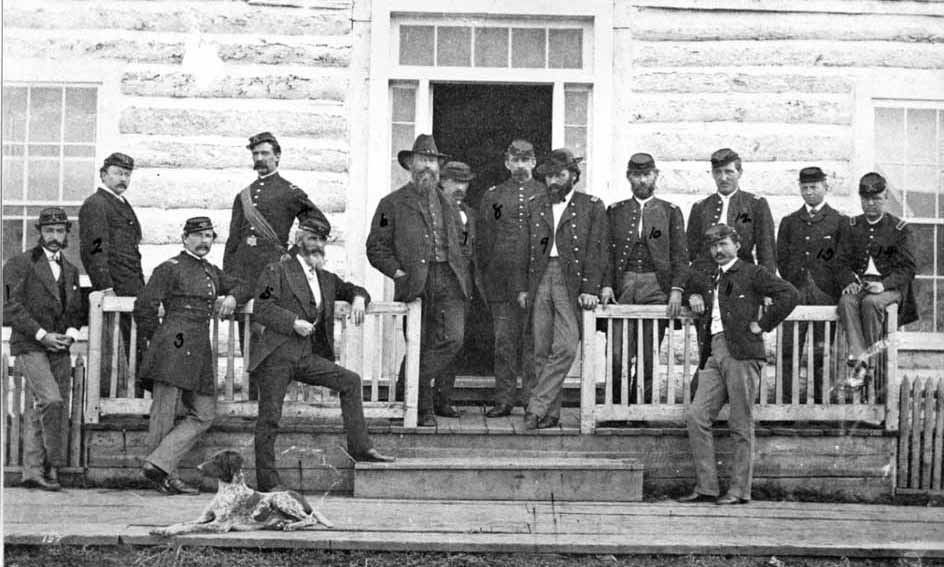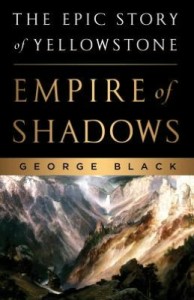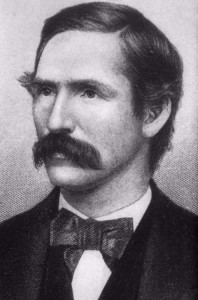
Gustavus Cheyeney Doane, fourth from left with sash, was a soldier who figures prominently in Empire of Shadows: The Epic Story of Yellowstone, by George Black. (Pioneer Museum - click to enlarge)
By Ruffin Prevost
CODY, WYO. — Yellowstone National Park looms large in the public imagination as an inspirational idea, unique landscape and critically important haven for wildlife. But according to one author and historian, its creation resulted as much from violence, ambition and greed as from high-minded ideals.
The patterns outlined in George Black’s, Empire of Shadows: The Epic Story of Yellowstone, are hardly unique in American history, or any other history, for that matter. But they may come as a jolt to those who mistakenly believe that Yellowstone was devoid of people until the arrival of white Americans in the second half of the 19th century.

Empire of Shadows: The Epic Story of Yellowstone, by George Black.
“Central to the idea of Yellowstone was that it was pristine in every way, including that it was free of any human habitation,” Black said Friday during a discussion of his book at the Buffalo Bill Historical Center in Cody, Wyo.
Black will also speak Wednesday in Missoula, Mont.
One popular but false belief since the park’s founding was that Plains Indians avoided Yellowstone based on superstitions about its geysers and other thermal features, Black said. It is only in the last 50 years that historians have begun to fully understand how Native people populated Yellowstone.
In fact, there was a long history of tribes criss-crossing the park frequently, including trips to Obsidian Cliff to gather material for making knives and projectile points. A small band of Shoshone Indians, the Sheepeaters, were permanent residents of the park, Black said.
Black’s book details efforts by the U.S. military and early settlers to subdue Native tribes living around the park, particularly the Blackfeet. Black said the Blackfeet were viewed by white settlers as “masters of the horse and notoriously aggressive and competitive.”
“They were the principal explanation for more than 60 years of why it was simply too dangerous for white men to explore” much of Yellowstone country, Black said.
Despite the focus in his book on the violence of the Indian wars, the greed that came with fur trapping and mining and the naked personal ambition of a host of soldiers, settlers, promoters and speculators, Black said the birth of Yellowstone has to be viewed in the context its era.
“This is not in any way an exposé of the dark side of Yellowstone,” he said. “These were men of their time, and it was a violent time. They were part of the complexity in which you have to see all human beings.”
A lawless lot
The first white people in Yellowstone country were a lawless lot, Black said. They were “secessionists, draft-dodgers, straight criminals, and scoundrels of all description, including people that wanted to get rich quick, and a small number of highly educated Eastern men.”

Cornelius Hedges (click to enlarge)
That included men like Nathaniel Pitt Langford, Cornelius Hedges and Gustavus Cheyney Doane. All three traveled together as part of the 1870 Washburn expedition to Yellowstone, and each figures prominently in Black’s book, although none more than Doane. Langford and Hedges were educated Freemasons who wanted to “civilize” the West, remaking it in the image of America’s Eastern cities.
Doane, however, was a soldier with a lifelong ambition to become a famous explorer. Like many, he saw Yellowstone as the last great unexplored country in America, and he hoped to gain fame and fortune from charting its mysteries.
Instead, he was assigned to various military campaigns against the Indians, including a January 1870 raid on a Piegan village on the Marias River in Montana that saw 173 members of the Blackfeet band slaughtered, mostly women and children.
It is from a passage by Doane, who described in his journal seeing the Black Canyon of Yellowstone in August 1870, that Black draws the title of his book.
“It is grand, gloomy, and terrible; a solitude peopled with fantastic ideas, an empire of shadows and of turmoil,” Doane wrote.
A command in Yellowstone
More than two decades later, after Yellowstone had been made a national park, poachers and opportunists threatened the wildlife and thermal features that had made it worthy of protection in the first place. The federal government finally decided to post troops in the park to save the last of the bison and check the encroaching exploitation.
Doane wrote to a friend, asking for help in a campaign to have himself appointed to lead the Army outpost that would soon be stationed in Mammoth Hot Springs.
“I want command of the Yellowstone National Park. If I have not deserved it, justice is a mockery, merit a scandal, gratitude a farce and liberty a lie,” Doane wrote. “I remember the day when we slaughtered the Piegans, how it occurred to me, as I sat down in the bank of the Marias and watched the stream of their blood, which ran down on the surface of the frozen river over half a mile, that the work we were then doing would be rewarded, as it has been.”
Doane’s request for command of Yellowstone was denied, and he died soon after, in 1892. History would not place his name alongside the great explorers he idolized in his youth.
In his book, Black describes the history of Yellowstone as “a quintessentially American story, of terrible things done in the name of high ideals, and of high ideals realized by dubious means.”
John Rumm, curator of the Buffalo Bill Museum, agreed, calling Black “a gifted storyteller who knows how to write well.”
“He is an explorer both of unspoiled nature, with its incredible vistas,” Rumm said of Black, “and of human nature, with its paradoxes and variabilities.”
If you go…
George Black, author of Empire of Shadows: The Epic Story of Yellowstone, will speak at 7 p.m. Wed., Sept. 5, at the University of Montana in Gallagher Business Building Room 123.
Contact Ruffin Prevost at 307-213-9818 or ruffin@yellowstonegate.com.
